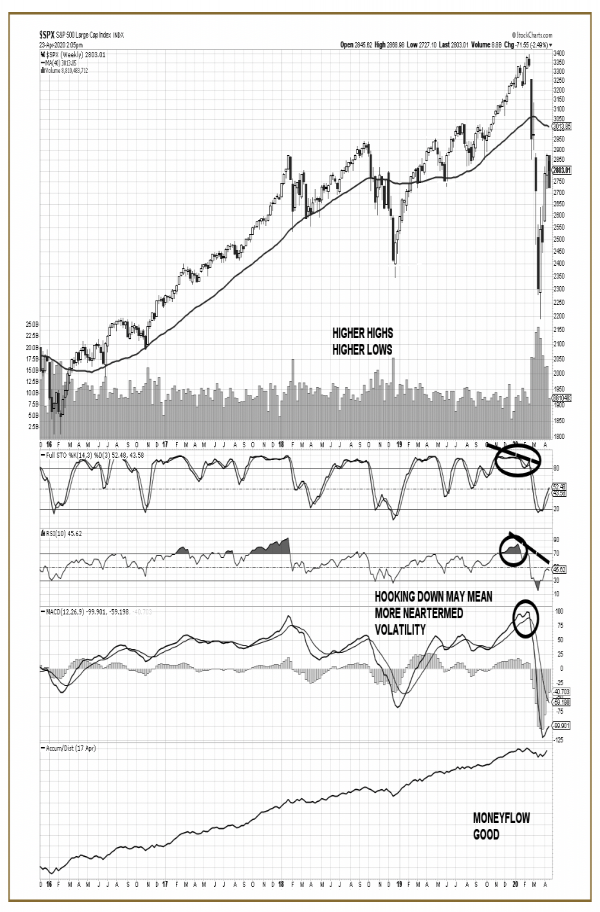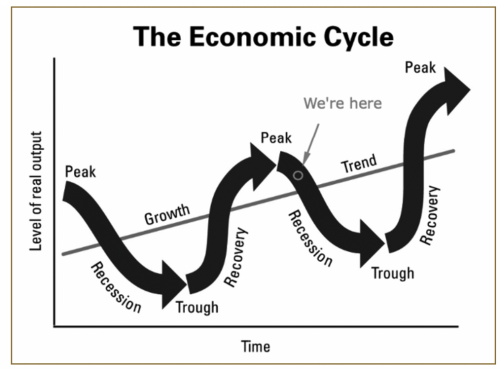Back To Basics
 Readers of my blog (www.valuetrend.ca) know that I incorporate traditional technical trend analysis with another tool I call my “Bearometer”. I look at the ValueTrend Bearometer at least once a month and report its level on the blog. But that indicator is not a pure technical rating mechanism. It focuses as much on factors like market sentiment, breadth, and seasonality along with valuation metrics as it does on trends. It rolls them all into a ball and spits out a general view of risk/reward.
Readers of my blog (www.valuetrend.ca) know that I incorporate traditional technical trend analysis with another tool I call my “Bearometer”. I look at the ValueTrend Bearometer at least once a month and report its level on the blog. But that indicator is not a pure technical rating mechanism. It focuses as much on factors like market sentiment, breadth, and seasonality along with valuation metrics as it does on trends. It rolls them all into a ball and spits out a general view of risk/reward.
Sometimes, we lose sight of the forest for the trees. So today, I thought I would go back to the basics of what I look at when first viewing a chart of the S&P 500 in order to determine its potential trend. Technically, there are some factors I look at on most charts. For example, let us use a weekly chart of the SPX and look at (in order of importance):
Trend (trendlines, peaks, troughs, formations): This isn’t rocket surgery, folks. An uptrend is observed by a series of rising peaks and troughs on a weekly stock market chart. A downtrend is quantified by observing lower peaks and troughs. Simple, yet elegant. To confirm a downtrend, I look at the 200-day simple moving average. If the market is above the 200-day moving average, it’s bullish. If it’s below the 200-day moving average—it’s bearish. On the chart below, note my prior indications of higher peaks and troughs. The recent selloff put in a lower low and very definitively broke the 200-day SMA. Trend indicates a bear market at this time.
Moneyflow: The Accumulation/Distribution line cumulatively tracks the percentage the market went up or down on a given day and its volume. That percentage is multiplied by volume. If the general trend is for stocks moving higher on strong volume, that’s good. If prices are rising but volume is shrinking, it implies less money is chasing those gains. Falling prices on strong volume is a problem. The A/D line (bottom pane) is still on trend. But it’s dipped in the near term. So, it’s weakening in the near term. Money isn’t coming into the market. You don’t want to see that continue.
Volume (volume bars): Basically, I want to see if volume is confirming the trend. If it diverges against trend (shrinks) over a reasonable period, that gives us clues to a potential change. Note on the chart how volume rose in the selloff, then fell in the recent rally. This indicates that there were far more enthusiastic sellers than there were enthusiastic buyers. Fear of Losing Money (FOLM) was a strong motivator in the decline. Fear of Missing Out (FOMO) has been a weaker motivator on the rally. That’s not good.
Momentum (MACD - Moving Average Convergence Divergence, RSI - Relative Strength Index, Stochastics): MACD is a longer-termed momentum oscillator that measures short vs. long-termed moving average differentials. As such, it gives longer-termed clues, particularly if it crosses or diverges. RSI is a mid-termed view of market momentum, helping us with overbought and oversold situations, along with divergence signals. Stochastics is a short-termed momentum oscillator, providing very near term signals for overbought/ oversold situations. It can also be watched for divergences. The first three panes below the price chart of the S&P 500 are (respectively) stochastics, RSI, and MACD. The bullish hooks and crossovers on Stochastics and RSI are positive. Both of these indicators diverged negatively before the crash, giving some signs of danger ahead of time. RSI is just coming up to the diverging trendline. Will it fail here? The MACD is hooking up but not crossing over its nine-week moving average (top solid line), so that might indicate a bearish head-fake. I left my notes on this chart below—you can see I was wondering if the bearish MACD cross earlier in the year might lead to volatility. I guess it did…

“The Economy, Stupid” (James Carville)
An investor also must factor in the current economic environment. I’m not an economist. But it doesn’t take one to know if we are generally in a growth or recessionary phase of the economy. Where are we now? If you guessed “recession”, well, you don’t win a prize. The question was too easy.
In a perfect world, it’s usually best to own stocks until the growth cycle ends and sell at the end of that cycle. Oh, but if it were only that easy to do so!
To carry on with our perfect analysis plan: You want to try and re-buy stocks before the bottom of the recession. But not too early. That’s because markets will fall initially, but then rise ahead of an anticipated recovery.
Nobody can do this perfect buy and sell plan with too much accuracy. But we can make a guess as to where we are in the economic cycle and use the trend analysis noted above for additional input. Here’s a chart (courtesy of Vanguard) of the economic cycle. It has a notation of where we might be that mirrors my guess…

Some Final Thoughts Backing The Prognosis That It Is Too Early To Start Loading Up On Stocks:
Don’t fight the Fed is a valid saying. That’s the entire reason the market staged its April rally. Still, I hold that it is too early to expect that the Fed alone can drive markets back to their February highs anytime soon. It is almost unheard of that a worldwide catastrophe such as we’ve seen will be reversed in a few months. For that reason, I hold (now) 35% cash in our equity model given the potential for another selloff over the summer. If I’m wrong, fine. I underperform the markets by about a third. But if I’m right about another leg down, or some sort of re-test of the March lows in the coming months, I will suffer about a third less in losses. That, plus I will have cash to buy stocks at another market low point. From my perspective, the odds for a second market pullback outweigh the odds for a quick return to the bull market.
Wrong or right, I have a plan. Do you?
Keith Richards is Chief Portfolio Manager & President of ValueTrend Wealth Mgmt. He can be contacted at info@valuetrend.ca. He may hold positions in the securities mentioned. The information provided is general in nature and does not represent investment advice. It is subject to change without notice and is based on the perspectives and opinions of the writer only. It may also contain projections or other “forward-looking statements”. There is significant risk that forward-looking statements will not prove to be accurate and actual results, performance, or achievements could differ materially from any future results, performance, or achievements that may be expressed or implied by such forward-looking statements and you will not unduly rely on such forward-looking statements. Every effort has been made to compile this material from reliable sources; however, no warranty can be made as to its accuracy or completeness. Before acting on any of the above, please consult an appropriate professional regarding your particular circumstances.

